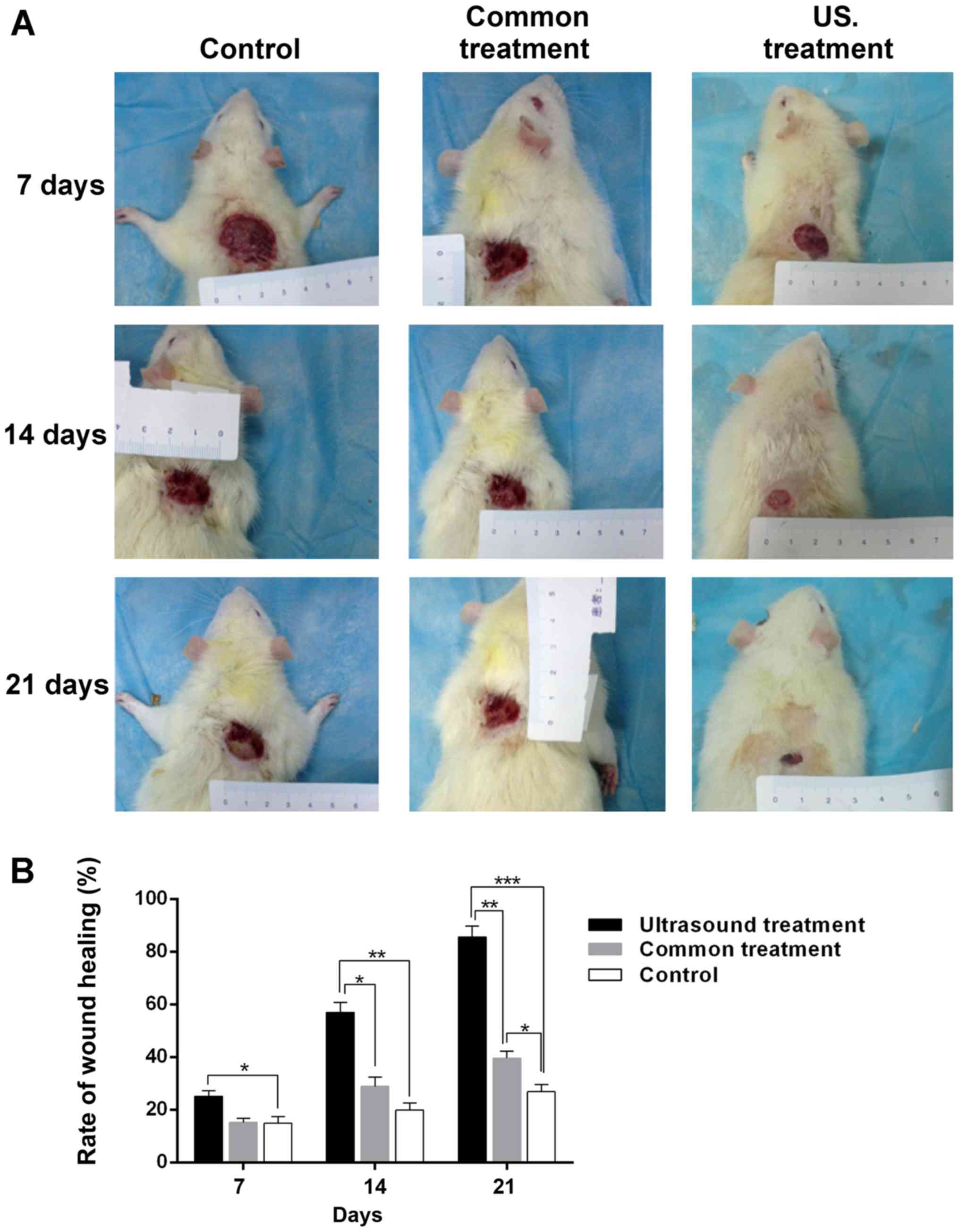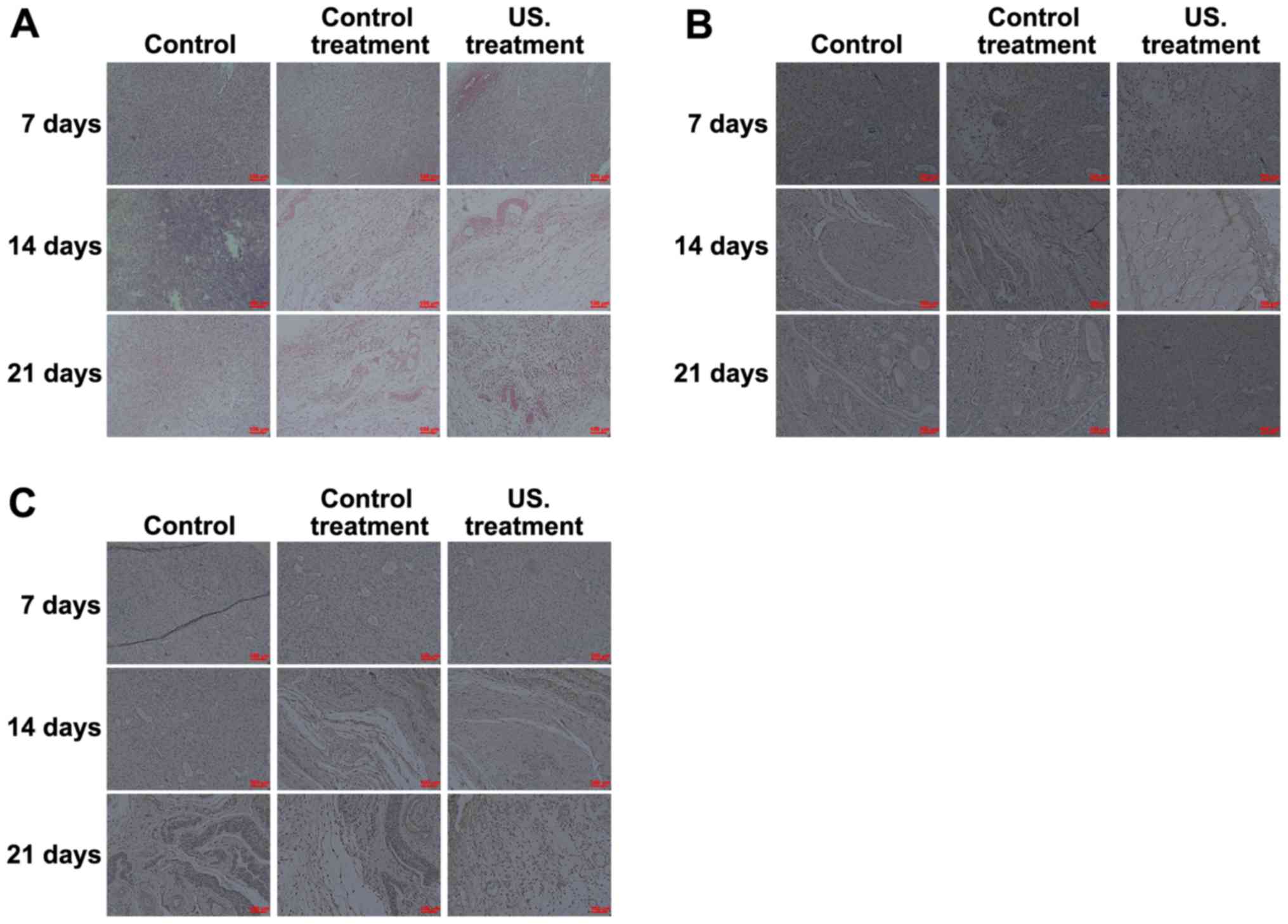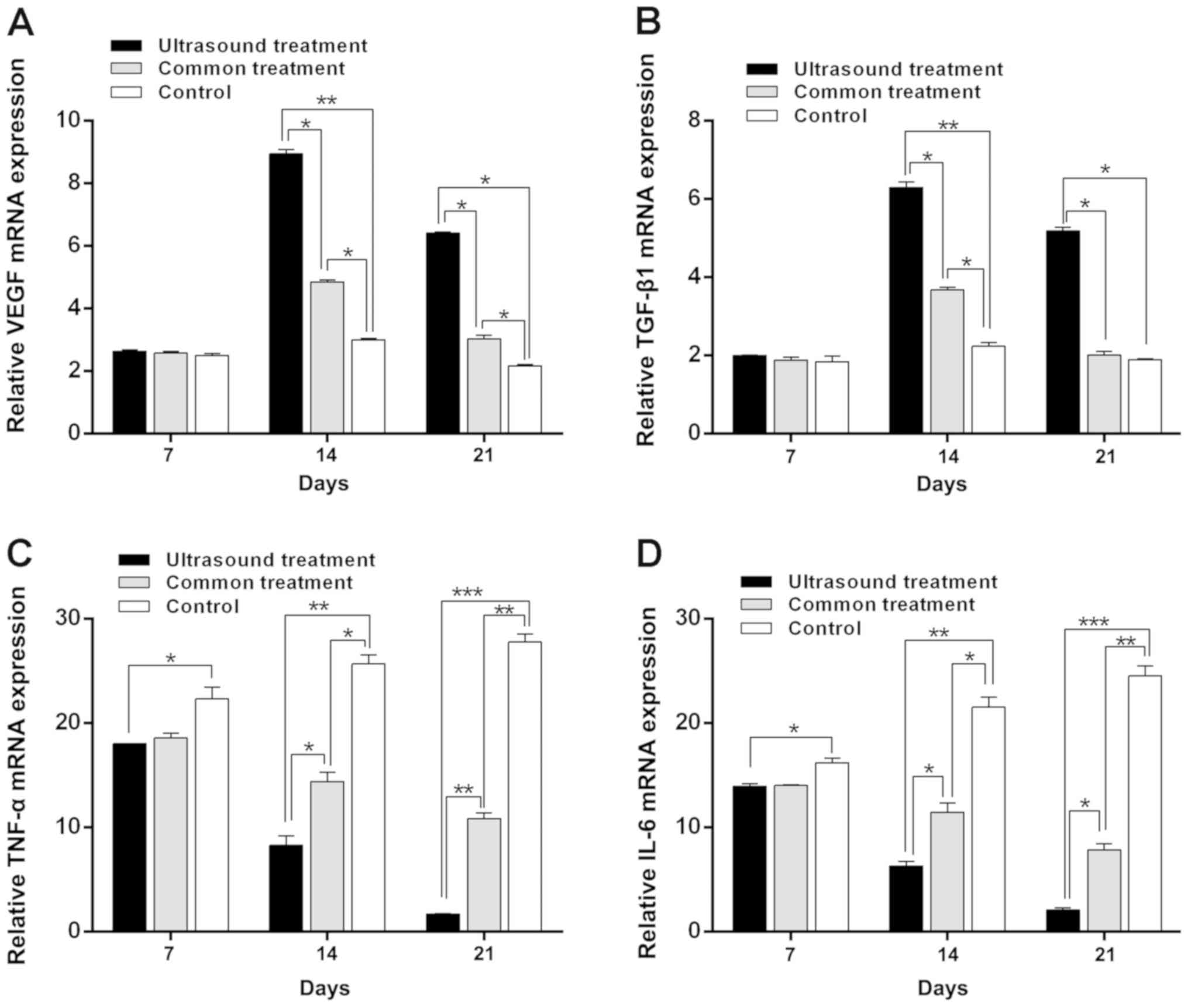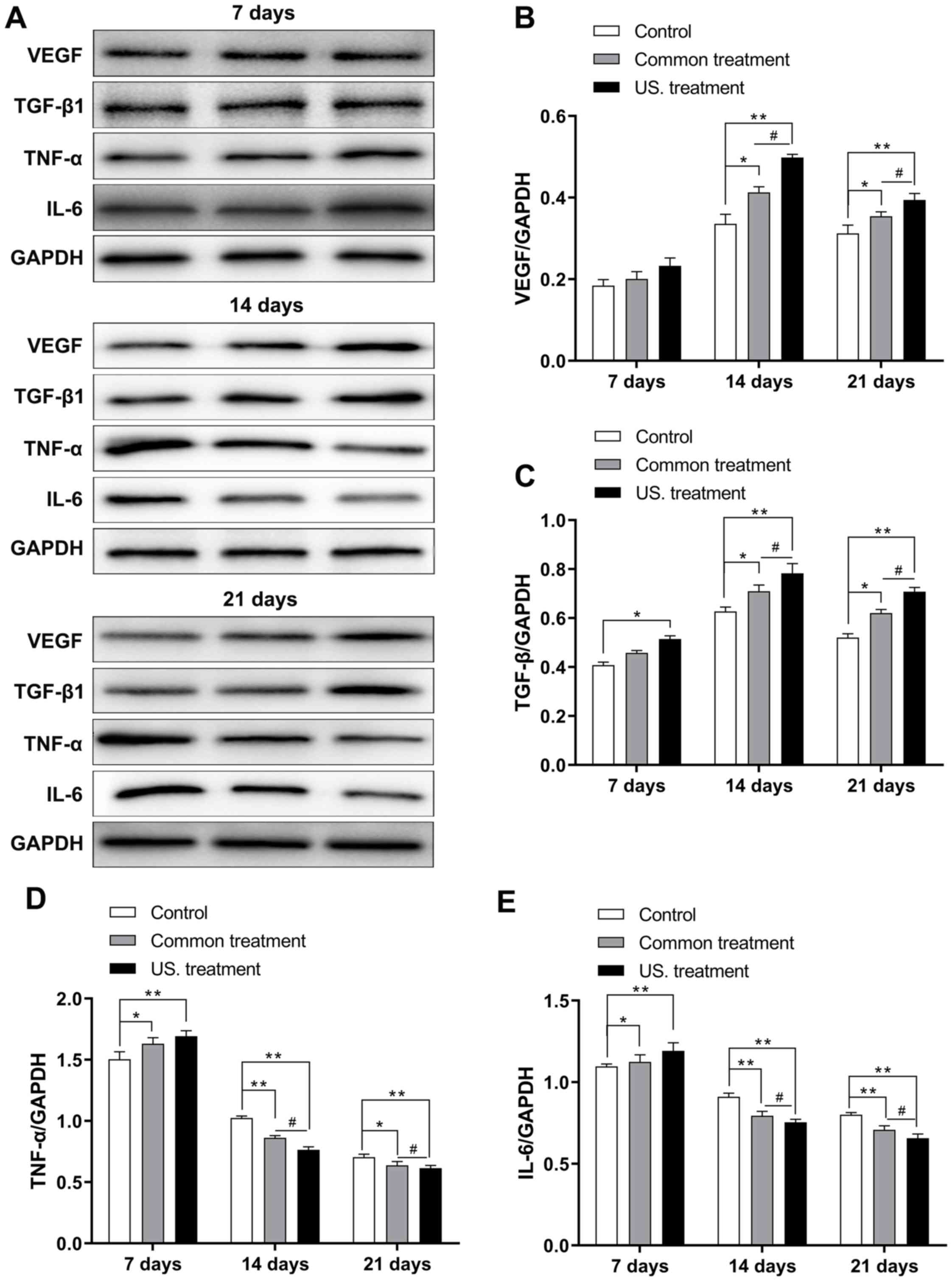|
1
|
Cho NH, Shaw JE, Karuranga S, Huang Y, da
Rocha Fernandes JD, Ohlrogge AW and Malanda B: IDF Diabetes Atlas:
Global estimates of diabetes prevalence for 2017 and projections
for 2045. Diabetes Res Clin Pract. 138:271–281. 2018. View Article : Google Scholar : PubMed/NCBI
|
|
2
|
Kuo YR, Wang CT, Cheng JT, Kao GS, Chiang
YC and Wang CJ: Adipose-derived stem cells accelerate diabetic
wound healing through the induction of autocrine and paracrine
effects. Cell Transplant. 25:71–81. 2016. View Article : Google Scholar : PubMed/NCBI
|
|
3
|
Zahedi A and Ebrahimi M: Statistical
comments on ‘The effect of foot exercise on wound healing in type 2
diabetes patients with a foot ulcer’. J Wound Ostomy Continence
Nurs. 45:2982018. View Article : Google Scholar : PubMed/NCBI
|
|
4
|
Li G, Zou X, Zhu Y, Zhang J, Zhou L, Wang
D, Li B and Chen Z: Expression and influence of matrix
metalloproteinase-9/tissue inhibitor of metalloproteinase-1 and
vascular endothelial growth factor in diabetic foot ulcers. Int J
Low Extrem Wounds. 16:6–13. 2017. View Article : Google Scholar : PubMed/NCBI
|
|
5
|
Fernando ME, Seneviratne RM, Tan YM,
Lazzarini PA, Sangla KS, Cunningham M, Buttner PG and Golledge J:
Intensive versus conventional glycaemic control for treating
diabetic foot ulcers. Cochrane Database Syst Rev. CD107642016.
|
|
6
|
Corrêa MG, Gomes CM, Marques MR, Casati
MZ, Nociti FH Jr and Sallum EA: Histometric analysis of the effect
of enamel matrix derivative on the healing of periodontal defects
in rats with diabetes. J Periodontol. 84:1309–1318. 2013.
View Article : Google Scholar : PubMed/NCBI
|
|
7
|
Dumville JC, Deshpande S, O'Meara S and
Speak K: Hydrocolloid dressings for healing diabetic foot ulcers.
Cochrane Database Syst Rev. CD0090992012.PubMed/NCBI
|
|
8
|
Berlanga-Acosta J, Fernández-Montequín J,
Valdés-Pérez C, Savigne-Gutiérrez W, Mendoza-Marí Y, García-Ojalvo
A, Falcón-Cama V, García Del Barco-Herrera D, Fernández-Mayola M,
Pérez-Saad H, et al: Diabetic foot ulcers and epidermal growth
factor: Revisiting the local delivery route for a successful
outcome. Biomed Res Int. 2017:29237592017. View Article : Google Scholar : PubMed/NCBI
|
|
9
|
Lefrancois T, Mehta K, Sullivan V, Lin S
and Glazebrook M: Evidence based review of literature on detriments
to healing of diabetic foot ulcers. Foot Ankle Surg. 23:215–224.
2017. View Article : Google Scholar : PubMed/NCBI
|
|
10
|
Brantley JN and Verla TD: Use of placental
membranes for the treatment of chronic diabetic foot ulcers. Adv
Wound Care (New Rochelle). 4:545–559. 2015. View Article : Google Scholar : PubMed/NCBI
|
|
11
|
Catrina SB and Zheng X: Disturbed hypoxic
responses as a pathogenic mechanism of diabetic foot ulcers.
Diabetes Metab Res Rev. 32 (Suppl 1):S179–S185. 2016. View Article : Google Scholar
|
|
12
|
Adeghate J, Nurulain S, Tekes K, Fehér E,
Kalász H and Adeghate E: Novel biological therapies for the
treatment of diabetic foot ulcers. Expert Opin Biol Ther.
17:979–987. 2017. View Article : Google Scholar : PubMed/NCBI
|
|
13
|
Ferroni L, Gardin C, De Pieri A, Sambataro
M, Seganfreddo E, Goretti C, Iacopi E, Zavan B and Piaggesi A:
Treatment of diabetic foot ulcers with Therapeutic Magnetic
Resonance (TMR®) improves the quality of granulation
tissue. Eur J Histochem. 61:28002017. View Article : Google Scholar : PubMed/NCBI
|
|
14
|
Tan L, Hou Z and Gao Y: Efficacy of
combined treatment with vacuum sealing drainage and recombinant
human epidermal growth factor for refractory wounds in the
extremities and its effect on serum levels of IL-6, TNF-α and IL-2.
Exp Ther Med. 15:288–294. 2018.PubMed/NCBI
|
|
15
|
Basso FG, Pansani TN, Turrioni AP, Soares
DG, de Souza CC and Hebling J: Tumor necrosis factor-α and
interleukin (IL)-1β, IL-6, and IL-8 impair in vitro migration and
induce apoptosis of gingival fibroblasts and epithelial cells,
delaying wound healing. J Periodontol. 87:990–996. 2016. View Article : Google Scholar : PubMed/NCBI
|
|
16
|
Zhou J, Ni M, Liu X, Ren Z and Zheng Z:
Curcumol promotes vascular endothelial growth factor
(VEGF)-mediated diabetic wound healing in streptozotocin-induced
hyperglycemic rats. Med Sci Monit. 23:555–562. 2017. View Article : Google Scholar : PubMed/NCBI
|
|
17
|
Yoon D, Yoon D, Cha HJ, Lee JS and Chun W:
Enhancement of wound healing efficiency mediated by artificial
dermis functionalized with EGF or NRG1. Biomed Mater. 13:450072018.
View Article : Google Scholar
|
|
18
|
Zhengcai-Lou, Zihan-Lou and Yongmei-Tang:
Comparative study on the effects of EGF and bFGF on the healing of
human large traumatic perforations of the tympanic membrane.
Laryngoscope. 126:E23–E28. 2016. View Article : Google Scholar : PubMed/NCBI
|
|
19
|
Fekrazad R, Sarrafzadeh A, Kalhori KAM,
Khan I, Arany PR and Giubellino A: Improved wound remodeling
correlates with modulated TGF-beta expression in skin diabetic
wounds following combined red and infrared photobiomodulation
treatments. Photochem Photobiol. 94:775–779. 2018. View Article : Google Scholar : PubMed/NCBI
|
|
20
|
Abdoli A, Maspi N and Ghaffarifar F: Wound
healing in cutaneous leishmaniasis: A double edged sword of IL-10
and TGF-β. Comp Immunol Microbiol Infect Dis. 51:15–26. 2017.
View Article : Google Scholar : PubMed/NCBI
|
|
21
|
Karam RA, Rezk NA, Abdel Rahman TM and Al
Saeed M: Effect of negative pressure wound therapy on molecular
markers in diabetic foot ulcers. Gene. 667:56–61. 2018. View Article : Google Scholar : PubMed/NCBI
|
|
22
|
Lopes L, Setia O, Aurshina A, Liu S, Hu H,
Isaji T, Liu H, Wang T, Ono S, Guo X, et al: Stem cell therapy for
diabetic foot ulcers: A review of preclinical and clinical
research. Stem Cell Res Ther. 9:1882018. View Article : Google Scholar : PubMed/NCBI
|
|
23
|
Chen CY, Wu RW, Hsu MC, Hsieh CJ and Chou
MC: Adjunctive hyperbaric oxygen therapy for healing of chronic
diabetic foot ulcers: A randomized controlled trial. J Wound Ostomy
Continence Nurs. 44:536–545. 2017. View Article : Google Scholar : PubMed/NCBI
|
|
24
|
Asadi MR, Torkaman G, Hedayati M,
Mohajeri-Tehrani MR, Ahmadi M and Gohardani RF: Angiogenic effects
of low-intensity cathodal direct current on ischemic diabetic foot
ulcers: A randomized controlled trial. Diabetes Res Clin Pract.
127:147–155. 2017. View Article : Google Scholar : PubMed/NCBI
|
|
25
|
Mills JL: Lower limb ischaemia in patients
with diabetic foot ulcers and gangrene: Recognition, anatomic
patterns and revascularization strategies. Diabetes Metab Res Rev.
32 (Suppl 1):S239–S245. 2016. View Article : Google Scholar
|
|
26
|
Blume P and Wu S: Updating the diabetic
foot treatment algorithm: Recommendations on treatment using
advanced medicine and therapies. Wounds. 30:29–35. 2018.PubMed/NCBI
|
|
27
|
Tardivo JP, Serrano R, Zimmermann LM,
Matos LL, Baptista MS, Pinhal MAS and Atallah ÁN: Is surgical
debridement necessary in the diabetic foot treated with
photodynamic therapy? Diabet Foot Ankle. 8:13735522017. View Article : Google Scholar : PubMed/NCBI
|
|
28
|
Campitiello F, Mancone M, Corte AD,
Guerniero R and Canonico S: An evaluation of an ultrasonic
debridement system in patients with diabetic foot ulcers: A case
series. J Wound Care. 27:222–228. 2018. View Article : Google Scholar : PubMed/NCBI
|
|
29
|
Volpe P, Marcuccio D, Stilo G, Alberti A,
Foti G, Volpe A, Princi D, Surace R, Pucci G and Massara M:
Efficacy of cord blood platelet gel application for enhancing
diabetic foot ulcer healing after lower limb revascularization.
Semin Vasc Surg. 30:106–112. 2017. View Article : Google Scholar : PubMed/NCBI
|
|
30
|
Uysal S, Ozturk AM, Tasbakan M, Simsir IY,
Unver A, Turgay N and Pullukcu H: Human myiasis in patients with
diabetic foot: 18 cases. Ann Saudi Med. 38:208–213. 2018.
View Article : Google Scholar : PubMed/NCBI
|
|
31
|
de Sousa ACT, da Rocha ÍBP, de Carvalho
AFM, de Freitas Coelho NPM, Feitosa MCP, Barros EML, Arisawa EALS
and de Amorim MRL: Comparative study between low level laser and
therapeutic ultrasound in second intention ulcers repair in mice. J
Lasers Med Sci. 9:134–138. 2018. View Article : Google Scholar : PubMed/NCBI
|
|
32
|
Liao AH, Hung CR, Chen HK and Chiang CP:
Ultrasound-mediated EGF-coated-microbubble cavitation in dressings
for wound-healing applications. Sci Rep. 8:83272018. View Article : Google Scholar : PubMed/NCBI
|
|
33
|
Murphy CA, Houghton P, Brandys T, Rose G
and Bryant D: The effect of 22.5 kHz low-frequency contact
ultrasound debridement (LFCUD) on lower extremity wound healing for
a vascular surgery population: A randomised controlled trial. Int
Wound J. 15:460–472. 2018. View Article : Google Scholar : PubMed/NCBI
|
|
34
|
Sakamoto Y, Hojo M, Kosugi Y, Watanabe K,
Hirose A, Inomata A, Suzuki T and Nakae D: Comparative study for
carcinogenicity of 7 different multi-wall carbon nanotubes with
different physicochemical characteristics by a single
intraperitoneal injection in male Fischer 344 rats. J Toxicol Sci.
43:587–600. 2018. View Article : Google Scholar : PubMed/NCBI
|
|
35
|
Winter GD: Effect of air exposure and
occlusion on experimental human skin wounds. Nature. 200:378–379.
1963. View
Article : Google Scholar : PubMed/NCBI
|
|
36
|
Johnson LE, Larsen M and Perez MT: Retinal
adaptation to changing glycemic levels in a rat model of type 2
diabetes. PLoS One. 8:e554562013. View Article : Google Scholar : PubMed/NCBI
|
|
37
|
Muhammad AA, Arulselvan P, Cheah PS, Abas
F and Fakurazi S: Evaluation of wound healing properties of
bioactive aqueous fraction from Moringa oleifera lam on
experimentally induced diabetic animal model. Drug Des Devel Ther.
10:1715–1730. 2016. View Article : Google Scholar : PubMed/NCBI
|
|
38
|
Zhang XN, Ma ZJ, Wang Y, Sun B, Guo X, Pan
CQ and Chen LM: Angelica Dahurica ethanolic extract improves
impaired wound healing by activating angiogenesis in diabetes. PLoS
One. 12:e01778622017. View Article : Google Scholar : PubMed/NCBI
|
|
39
|
Jerić M, Vukojević K, Vuica A and
Filipović N: Diabetes mellitus influences the expression of NPY and
VEGF in neurons of rat trigeminal ganglion. Neuropeptides.
62:57–64. 2017. View Article : Google Scholar : PubMed/NCBI
|
|
40
|
Livak KJ and Schmittgen TD: Analysis of
relative gene expression data using real-time quantitative PCR and
the 2(-Delta Delta C(T)) method. Methods. 25:402–408. 2001.
View Article : Google Scholar : PubMed/NCBI
|
|
41
|
Yan SF, Yan SD, Ramasamy R and Schmidt AM:
Tempering the wrath of RAGE: An emerging therapeutic strategy
against diabetic complications, neurodegeneration, and
inflammation. Ann Med. 41:408–422. 2009. View Article : Google Scholar : PubMed/NCBI
|
|
42
|
Sun M, He Y, Zhou T, Zhang P, Gao J and Lu
F: Adipose extracellular matrix/stromal vascular fraction gel
secretes angiogenic factors and enhances skin wound healing in a
murine model. Biomed Res Int. 2017:31057802017. View Article : Google Scholar : PubMed/NCBI
|
|
43
|
Patel S, Maheshwari A and Chandra A:
Biomarkers for wound healing and their evaluation. J Wound Care.
25:46–55. 2016. View Article : Google Scholar : PubMed/NCBI
|
|
44
|
Tsai JL, Lee YM, Pan CY and Lee AY: The
novel VEGF121-VEGF165 fusion attenuates angiogenesis and drug
resistance via targeting VEGFR2-HIF-1α-VEGF165/Lon signaling
through PI3K-AKT-mTOR pathway. Curr Cancer Drug Targets.
16:275–286. 2016. View Article : Google Scholar : PubMed/NCBI
|
|
45
|
Ishii T, Uchida K, Hata S, Hatta M, Kita
T, Miyake Y, Okamura K, Tamaoki S, Ishikawa H and Yamazaki J: TRPV2
channel inhibitors attenuate fibroblast differentiation and
contraction mediated by keratinocyte-derived TGF-β1 in an in vitro
wound healing model of rats. J Dermatol Sci. 90:332–342. 2018.
View Article : Google Scholar : PubMed/NCBI
|


















